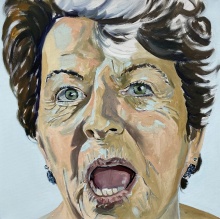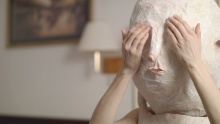Drewelowe Galley, Visual Arts Building
April 19-29, 2023
Closing reception April 28, 5-7 p.m.
Grant Wood Fellows Johanna Winters and Michael Dixon will present their work during a two-person show at the Drewelowe Gallery, located on the ground floor of the University of Iowa’s Visual Arts Building.
Dixon’s paintings, collectively displayed under the title, “Miscegenation Nation,” explores the story of his white mother Peggy amidst the fear of racial mixing in America. Anti-Miscegenation laws were in place across the country for 276-years. June 12th, 2022, marked the 55th anniversary of the landmark case, Loving v. Virginia, which made interracial marriage legal across the United States. Dixon is interested in how his mother navigated a cultural landscape that intentionally and legally promoted separation.
Winters will present a combination of videos, sculptural props, and collagraph prints titled “HOWW TO WAYT.” This work considers the condition of a puppet-protagonist who performs her sensuality for the camera. In a two-channel video at the center of the work, Winters manifests as the protagonist’s embodied chaperone as she readies for an encounter with an imagined romantic interest in a rehearsal for being desired.
The exhibition is free and open to the public, 8 a.m. to 8 p.m. daily.
Miscegenation Nation
Artist Statement
I was born in 1976 nine years after Loving v. Virginia. My mother is white and my father is black. I have never met my father. I often feel out of place and excluded within majority white and black spaces because of the way my racial identity is perceived as a light skinned bi-racial black man. What I have experienced is that I do not fit neatly into white culture or black culture but rather rest in the middle. Exploring this “in between” space has been the major focus of my creative work. My newest body of work is titled, Miscegenation Nation.
Anti-Miscegenation laws enforced racial segregation by criminalizing interracial marriage in America. The first anti-miscegenation law was passed by the Maryland General Assembly in 1691. Anti-Miscegenation laws were in place across the country for 276-years until the landmark US Supreme Court decision Loving v. Virginia in 1967 made these laws illegal. Alabama was the last state to remove anti-miscegenation laws from its statutes in the year 2000.
These laws allowed for white men to simultaneously control the sexual lives of white women and black men. By controlling the sexual lives of these demographics through legal measures, racist domination, and cultural norms white men had sole access to white and black women. White men could legally marry a white woman of their choosing plus use sexual violence, rape, and chattel slavery to have unchecked access to any black female they possessed. Additionally, white males used visual culture, literature, and science to create the stereotypes of black bodies as brutish, ugly, smelly, and dangerous. These harsh controls allowed for systematic oppression to take place across the country leaving white males largely in control over every other demographic using every means to maintain that control.
I am interested in my mother’s story. While the Supreme Court ruled that anti-miscegenation laws were illegal, cultural norms move much slower. She was a single white woman with a black baby. How was she treated? Did people stare? Did people make comments? What were the challenges and what were the rewards? This work is a celebration of my mother and my interpretation of her experiences. Peggy Ann Rumph (now Schendel) was born in San Diego, CA, in 1957. She is the second youngest out of six children born to Margaret and Ray Rumph from Hattiesburg, MS. I haven’t seriously painted my mother until now, and I haven’t fully conceptualized her story until now. This is a glimpse into Peggy’s life.
HOWW TO WAYT
Artist StatementHOWW TO WAYT is a new body of work comprised of videos, sculptural props, and works on paper that considers the condition of a puppet-protagonist who performs her sensuality for the camera. In a two-channel video at the center of the work, the artist manifests as the protagonist’s embodied chaperone as she readies for an encounter with an imagined romantic interest. The interiors of a sparse motel room become the protagonist’s staging grounds in a rehearsal for being desired.


